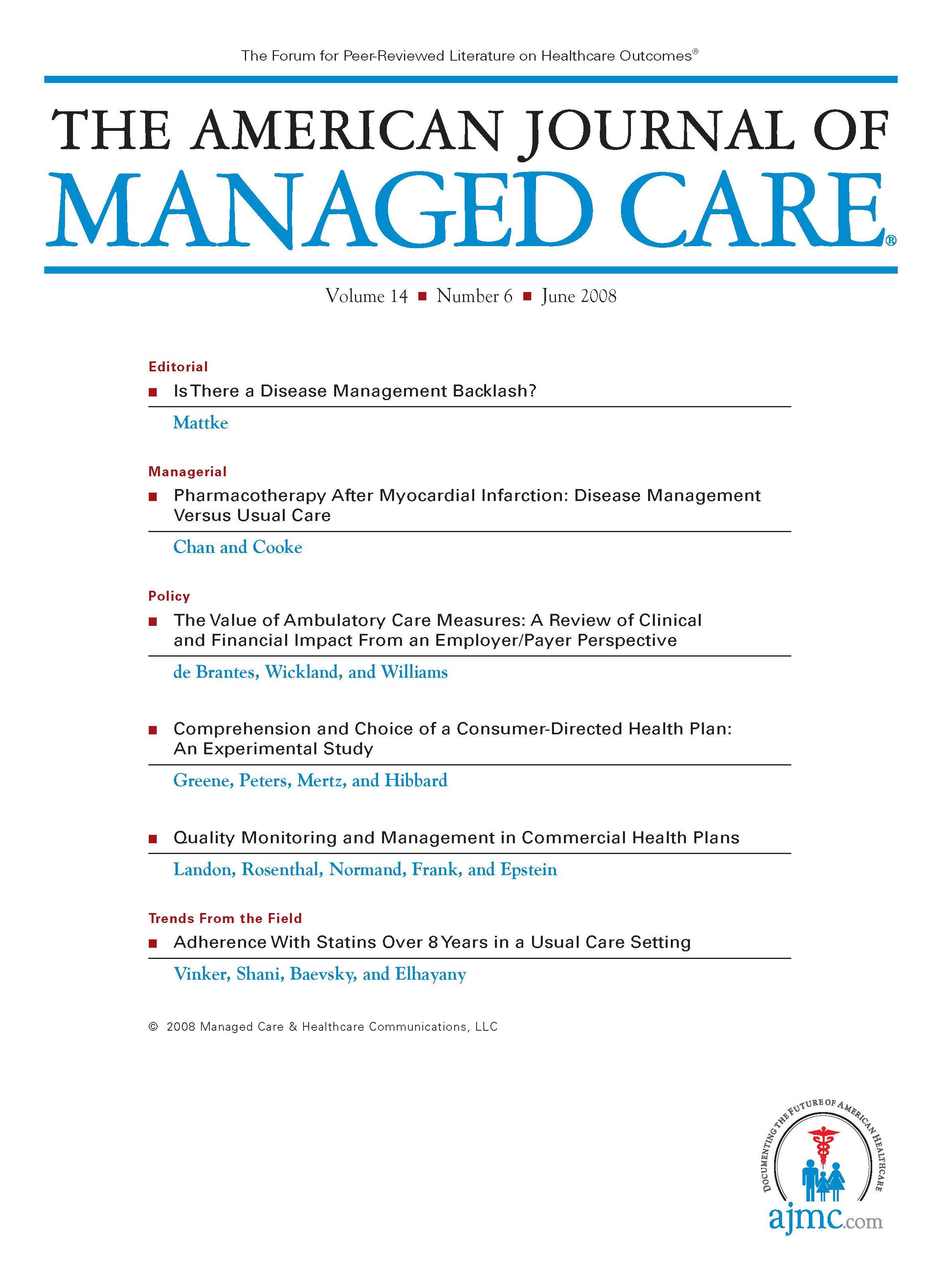- Center on Health Equity & Access
- Clinical
- Health Care Cost
- Health Care Delivery
- Insurance
- Policy
- Technology
- Value-Based Care
Toward National Healthcare Performance Standards
The healthcare system in the United States is themost expensive in the world, with by far thehighest total expenditure on health both on a percapita basis and as a percentage of the gross domesticproduct.1 And yet, according to the World HealthOrganization, the United States recently ranked 37th inoverall health system performance.2 Moreover, studieshave indicated that Americans receive only about half ofrecommended healthcare services.3
Efforts are under way now in many arenas to understandand address these discrepancies between cost andperformance. Among the most promising and mostintriguing are national-level initiatives addressing performancemeasures; that is, indicators that healthcareorganizations can use to determine and demonstrateeffectiveness at achieving results in virtually any aspectof healthcare delivery, from medical procedures andoutcomes to administrative functions.
A high-profile, congressionally mandated reportissued by the Institute of Medicine (IOM) last yeardescribed the nation's lack of a "coherent, goal-oriented,consistent and efficient system for assessing andreporting on the performance of the healthcare system"as a major obstacle to rapid progress in healthcare qualityimprovements.4 The IOM has called for a NationalQuality Coordinating Board, under the US Departmentof Health and Human Services, to develop standardizedhealth performance measures and track overallprogress.
Another group, the Ambulatory Care Quality Alliance(AQA), a joint effort of the American Academy of FamilyPhysicians, the American College of Physicians,America's Health Insurance Plans, and the Agency forHealthcare Research and Quality, is working to supportthe IOM's goal by directly and functionally advancingquality through performance measurement. The AQA'sData Sharing and Aggregation Workgroup, for example,recently recommended that "a public/private entityhave the primary responsibility of setting uniform operatingrules and standards for the sharing and aggregationof quality and efficiency data used in both the publicand private sectors, for the purposes of performancemeasurement and reporting."5
The IOM and AQA offer excellent and timely initiativesthat are worthy of strong support and rapidadvancement. We are fortunate in that many performancemeasures await evaluation for national use.HealthPartners, for example, was among many organizationscited by the IOM report for pioneering compositeperformance measures with the potential to serve asnational models—in this case, for diabetes treatment,coronary artery disease, and preventive care.6,7
To date, most performance measures have beendeveloped internally by individual organizations, suchthat on a national level they often are redundant or arenot comparable in some way to like measures used byothers.8 Without a nationally organized research anddevelopment capability, these innovations cannot beharvested systematically to advance the field. Persistentuse of homegrown measures in preference to standardizedapproaches slows and even halts the kinds of systemwidechanges needed to manage costs and improveresults for patients.
National performance standards hold vast potentialfor addressing these issues while transforming the overallapproaches to healthcare improvement. Implementedproperly, they will permit decision makers within thesystem to base clinical or operational improvements onproved methods with demonstrated results rather thanwell-intentioned but less effective measures of quality.Using national performance standards will permit comparisonsand benchmarking across organizations,drawing attention to groups performing well and identifyingsources of ideas and precedents for qualityimprovements. Useful and meaningful data will beavailable nationally. Consumers and payers will beable to make transparent and relevant comparisonswhen they are weighing choices among hospitals,providers, and procedures to select and fund.
National standardized measures will provide a solidfoundation to base financial incentives for medicalproviders to improve—to the consumers' and thenation's benefit. As the IOM report recommends, Congressshould authorize the modest $100 million to $200million in annual funding to create the National QualityCoordinating Board. For less than one tenth of 1% ofwhat the nation spends on Medicare ($278 billion in2003, according to the Centers for Medicare & MedicaidServices),9 we can take this significant and necessaryfirst step to realizing the full potential of national healthcareperformance standards. All involved within thehealthcare system—from providers to payers to politicians—should welcome the chance to participate in theformation and evolution of this system.
From HealthPartners, Inc, Minneapolis, Minn.
Address correspondence to: George J. Isham, MD, HealthPartners, Inc, PO Box 1309,Minneapolis, MN 55440-1309. E-mail: george.j.isham@healthpartners.com.
1. World Health Organization. Core health indicators. WHO Statistical InformationSystem (WHOSIS). Available at: http://www3.who.int/whosis/menu.cfm. AccessedMay 2006.
2. World Health Organization. The World Health Report 2000—Health Systems:Improving Performance. Available at: http://www.who.int/whr/2000/en/index.html.Accessed May 2006.
N Engl J Med.
3. McGlynn EA, Asch SM, Adams J, et al. The quality of health care delivered toadults in the United States. 2003;348:2635-2645.
Performance Measurement: Accelerating Improvement.
4. Institute of Medicine. Committee on Redesigning Health InsurancePerformance Measures, Payment, and Performance Improvement Programs.Washington, DC: TheNational Academies Press; 2006. Available at: http://darwin.nap.edu/books/0309100070/html/. Accessed May 2006.
5. Ambulatory Care Quality Alliance. Data Sharing And Aggregation Workgroup.National Health Data Steward. Available at: http://www.ambulatoryqualityalliance.org/files/HealthDataSteward-May06.doc. Accessed May 2006.
2005 Clinical Indicators Report: 2004/2005 Results.
6. HealthPartners, Inc. Minneapolis, Minn: HealthPartners, Inc; October 2005. Available at:http://www.healthpartners.com/files/28455.pdf. Accessed May 2006.
JAMA.
7. Nolan T, Berwick SM. All-or-none measurement raises the bar on performance. 2006;295:1168-1170.
PerformanceMeasurement: Accelerating Improvement.
8. Institute of Medicine. Committee on Redesigning Health InsurancePerformance Measures, Payment, and Performance Improvement Programs.Current and future state of performance measurement. In: Washington, DC: The NationalAcademies Press; 2006: chap 2. Available at: http://darwin.nap.edu/books/0309100070/html/33.html. Accessed May 2006.
9. Centers for Medicare & Medicaid Services. Office of Research, Development,and Information. 2004 CMS Statistics: Table 26. October 2004. CMS publication03455. Available at: http://www.cms.hhs.gov/CapMarketUpdates/02_CMSStatistics.asp.

Trends in Hospital Pricing for Vulnerable Emergency Department Users, 2021-2023
December 4th 2025Self-pay emergency department prices rose significantly from 2021 to 2023, especially at for-profit and system-affiliated hospitals, highlighting growing affordability challenges for uninsured and underinsured patients.
Read More
Integrated Care for Chronic Conditions: A Randomized Care Management Trial
December 3rd 2025The authors sought to understand the differential impact of payer-led community-based care management approaches on stakeholder-oriented outcomes for publicly insured adults with multiple chronic conditions.
Read More

